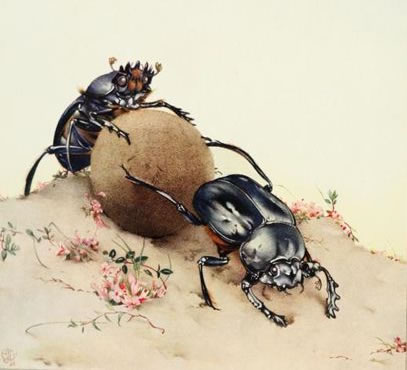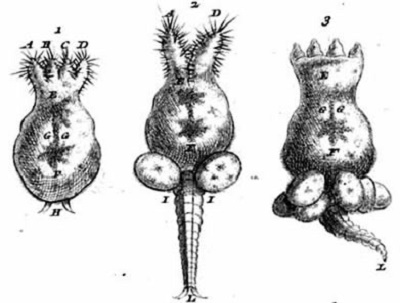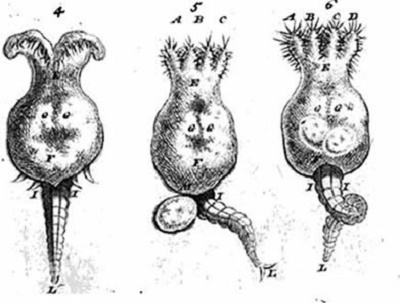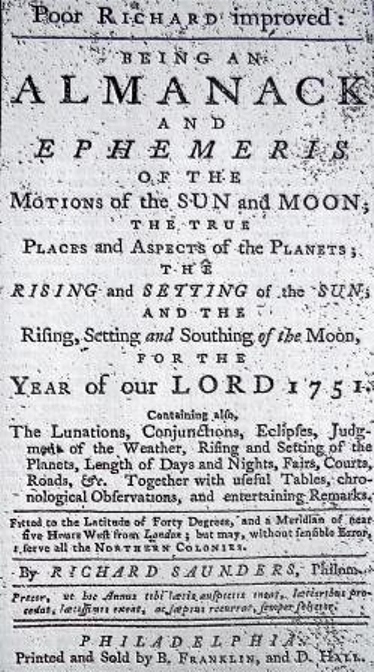Endless wonderment: Adventures with a microscope, by Richard Headstrom
Author: M. Crasnier-Mednansky, Ph.D., D.Sc.Copyright © 2010 Mednansky Institute, Inc.
Adventures with a Microscope is instructing and stimulating to both children and experienced students, and also comprehensible and intriguing to the laymen. It ought to trigger a vivid interest for nature in general and, in particular, the microscopic creatures found in ponds, pools, forests, on lands, rocks, walls, logs, trees… An experienced teacher and writerFootnote, Richard Headstrom explains where and how to collect samples for microscopic observation, what can be observed and why shapes, organs (and whatever can be seen) look the way they do; and why things are the way they are. Therefore, for example, the inquisitive eager child will naturally understand that he can do more than just observe, but experiment as well with a microscope.
Diagram illustrating action of the compound microscope
The object a is placed just outside the focus of a length O. A magnified and inverted image bc is formed. This image is itself magnified at BC by the eye-lens E. If the magnifying power of O is fifty and that of E four, the object is magnified two hundred times. This number is called the magnifying power of the microscope. Diagram is from Appletons' School PhysicsGoogleBook by John D. Quackenbos, Alfred M. Mayer, Silas W. Holman, Francis E. Nipher and Francis B. Crocker, 1891
Do not be mistaken, this precious book is much more than a 'how-to' guide, it is worth reading even - I must say - if you do not plan to use a microscope. It outlines life processes, and elicits a renewed appreciation for a concealed world and its diversity. Microscopic creatures are 'one-eye monsters', 'animated jelly' 'brick-makers' to cite a few, and life is full of shapes, motion, reproduction, weapons of defense, and so forth. Adventures with insects are quite extraordinary, for examples 'we learn how a fly walks upside down', 'we go marketing with a honey bee', 'we learn what it means to be stung', 'we view the most primitive insects', 'we observe the circulation of blood', 'we meet a champion'…
The sacred beetle
Frontispiece of FABRE'S BOOK OF INSECTS, 1921
The thrilling adventure starts with the much, by-now (you just read the book), coveted microscope. Before engaging with your observations you need first to hunt on site for the 'to-be-seen' creatures and features; some you can barely see with naked eyes (don't forget a hand lens), most you can't see at all. Keep in mind some are not available all year around, and all are sensitive to a changing environment, they may migrate from one pond to another, and they may even vanish from their once-recorded places. So you may like to keep track records!
By now you are an expert in handling your microscope, and most importantly you are developing observation skills with guidance from the book. The book is also a helpful tool for handling of your samples as well as their determination as it includes many through-the-microscope views. You can add a little chemistry, some coloring or a bit of surgery as it says!
Finally your meticulous work will go along with wonderment, as described by Richard Headstrom in one instance as follows. "You seem suddenly transported to a land of enchantment and you watch in silent admiration at the scene unfolded before you. And then, unaware of a quickening pulse and the feeling of excitement stealing over you, you perhaps jar the water ever so slightly, when, in a twinkling of the eye, all will have disappeared, as if you had seen a fleeting vision of another world. But this fleeting vision you can recapture, and if you remain quiet and motionless the enchanted garden will reappear, and all will be as beautiful and as lovely as before".
When microscopic observations meet with fancy: Louis Joblot's pomegranates

French microscopist Louis Joblot (1645-1723) examined animalcules in infusions with his self-made microscopes. He described the animalcules from dried wheat infusions as 'crowned and bearded aquatic pomegranates', in Descriptions et usages de plusieurs nouveaux microscopes by Louis Joblot, 1718, eBOOK at Open Library, Internet Archive
Footnote:
Richard Headstrom (1902-1985) published many books related to nature and natural history. He began his writing career while teaching for more than twenty years high school chemistry, physics and biology. He also worked as a curator of botany at the 'New England Museum of Natural History', and curator of entomology at the 'Worcester Museum of Science and Industry'. He was also a columnist for the Boston Globe, the Boston Transcript and the Worcester Telegram.
Suggested Reading:
Nature discoveries with a hand lens by Richard Headstrom, 1981 (ISBN 10: 0486240770, ISBN 13: 9780486240770)
The life of the bee by Maurice Maeterlinck, 1901 (ISBN10: 0486451437, ISBN13: 9780486451435]
Poor Richard's Almanac for 1751, by Benjamin Franklin. Excerpt: That admirable Instrument the MICROSCOPE has opened to us of these latter Ages, a World utterly unknown to the Ancients. There are very few Substances, in which it does not shew something curious and unexpected; but for the Sake of such Readers as are unacquainted with that Instrument, I shall set down some of the most remarkably entertaining Objects, upon which actual Observations have been made. Poor Richard's Almanac - 1751 Edition at Google Sites.

Suggested Performance:
Flight of the Bumblebee by nikolai Rimsky-Korsakov, performed by Berliner Philharmoniker conducted by Zubin Mehta (Well, now, my bumblebee, go on a spree, catch up with the ship on the sea, go down secretly, get deep into a crack…)
Minst.org Online Library Index